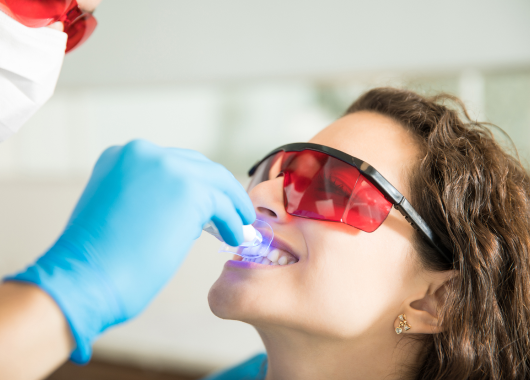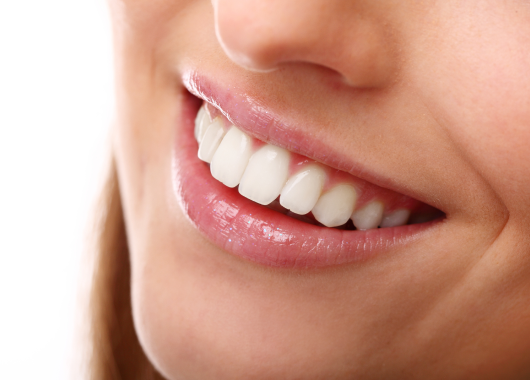Teeth Whitening Myths Debunked: What Actually Works?

A bright, dazzling smile is something most of us crave, and teeth whitening has become
a popular pursuit in the quest for that perfect grin. But with so much misinformation
floating around, it's easy to fall prey to myths that might do more harm than good. Let's
separate fact from fiction, dive into the myths about teeth whitening, and reveal what
truly works to achieve that pearly-white smile—no unicorn dust required!
Myth #1: Lemon Juice and Baking Soda Are the Best Natural Whiteners
Who hasn't heard the advice that scrubbing your teeth with lemon juice and baking soda
is the holy grail of whitening? It sounds like a promising, all-natural remedy, but hold on
before you start raiding your kitchen pantry.
The Reality: While lemon juice is acidic and baking soda is abrasive, together they
create a concoction that's more likely to damage your enamel than make your teeth
sparkle. The acid from the lemon juice can erode the enamel, leaving your teeth more
vulnerable to staining, sensitivity, and cavities. And the abrasive nature of baking soda
can cause micro-scratches, which can actually make your teeth appear duller over time.
What Actually Works: Stick to using a fluoride toothpaste with mild whitening
properties. Fluoride helps strengthen your enamel, and whitening toothpaste can gently
remove surface stains without damaging your teeth. It's a win-win—no lemon squeezing
required!
Myth #2: Whitening Toothpaste Will Make Your Teeth Blindingly White
Many people believe that using whitening toothpaste alone will turn their teeth into
glowing white beacons, visible from outer space. But is that really true?
The Reality: Whitening toothpaste is effective at removing surface stains, but it won't
dramatically change the natural color of your teeth. Most whitening toothpastes contain
mild abrasives or gentle polishing agents that help lift surface stains caused by coffee,
tea, or red wine. However, they don't contain bleaching agents strong enough to alter
the intrinsic color of your teeth.
What Actually Works: For a more noticeable change in tooth color, professional
whitening treatments provided by your dentist are the way to go. These treatments
contain higher concentrations of bleaching agents like hydrogen peroxide, which
penetrate deeper into the enamel to lighten stains. Just remember, this isn't a magic
wand—it might take a few sessions to achieve the shade you want.
Myth #3: Charcoal Toothpaste Is the Secret to a Hollywood Smile
Charcoal toothpaste has become a trendy favorite, with many influencers swearing by
its miraculous whitening effects. But is it truly the miracle product it's made out to be, or
just another marketing gimmick?
The Reality: While charcoal toothpaste can help remove surface stains, it's often too
abrasive for regular use. Its gritty texture can wear down enamel over time, leading to
sensitivity and increased vulnerability to staining. Plus, there's no scientific evidence
proving that charcoal is more effective than traditional whitening toothpaste.
What Actually Works: If you're keen on using something more effective, opt for dentist-
approved whitening gels or strips. These products contain safe, enamel-friendly
bleaching agents that offer noticeable results without the risk of damaging your teeth.
Myth #4: Whitening Damages Your Teeth Permanently
You might have heard whispers that whitening treatments strip away enamel, leaving
your teeth weak and prone to future damage. This myth might be the reason some
people avoid whitening altogether, but is there any truth to it?
The Reality: When done correctly, teeth whitening does not damage your enamel or
make your teeth more prone to decay. Professional whitening treatments and over-the-
counter products approved by dental associations are formulated to be safe and
effective. The hydrogen peroxide or carbamide peroxide in these products targets stains
without compromising the integrity of your enamel.
What Actually Works: Always follow the instructions provided with your whitening
products, and if you're unsure, consult your dentist before starting any treatment. This
will ensure you're using a method that's safe and suitable for your teeth. Remember,
more isn't always better—overdoing whitening treatments can lead to sensitivity.
Myth #5: Whitening Works the Same on All Teeth
There's a common belief that whitening treatments will work wonders on every set of
teeth, no matter the shade. But if that were true, we'd all have the same dazzling smiles
by now, wouldn't we?
The Reality: Whitening results vary from person to person and are influenced by factors
like age, genetics, diet, and the type of stains on your teeth. For example, yellowish
stains caused by coffee or tobacco are usually easier to whiten, while grayish stains
from medication or age are more resistant to bleaching.
What Actually Works: If you have stubborn stains or discoloration, it's best to consult
your dentist to determine the most effective treatment for your specific situation. They
might suggest in-office treatments or custom-made whitening trays that provide more
targeted and uniform results.
Myth #6: You Only Need to Whiten Your Teeth Once
 Many people believe that teeth whitening is a one-and-done deal, expecting their teeth
to stay bright forever after a single treatment. But sadly, that's not how life—or
whitening—works.
Many people believe that teeth whitening is a one-and-done deal, expecting their teeth
to stay bright forever after a single treatment. But sadly, that's not how life—or
whitening—works.
The Reality: The effects of whitening aren't permanent. Factors such as diet, lifestyle,
and oral hygiene habits play a significant role in how long your results last. Regular
consumption of staining beverages (like coffee, tea, or red wine) can cause your teeth
to darken again over time.
What Actually Works: To maintain your bright smile, touch-up treatments are
necessary every few months, or as recommended by your dentist. Also, rinse your
mouth with water after consuming staining foods or drinks, and maintain good oral
hygiene to prolong the effects.
Myth #7: Whitening Will Work on Crowns, Veneers, and Fillings
Have you ever thought you could whiten your crowns, veneers, or fillings to match your
teeth? Sorry to break it to you, but this myth is far from reality.
The Reality: Whitening treatments are designed to work on natural teeth only. They
won't have any effect on dental restorations like crowns, veneers, or fillings. So, if you
try to whiten them, you might end up with mismatched shades—not exactly the look you
were going for!
What Actually Works: If you're concerned about the color of your restorations, consult
your dentist. They can offer options for replacing or polishing them to match your newly
whitened teeth.
Myth #8: The Harder You Brush, the Whiter Your Teeth Will Be
Brushing your teeth vigorously might seem like an easy way to scrub away stains and
achieve a whiter smile, but this approach can actually cause more harm than good.
The Reality: Brushing too hard can wear down enamel and cause gum recession,
which not only leads to sensitivity but can also make your teeth appear yellow (since the
underlying dentin becomes more visible as enamel thins).
What Actually Works: Use a soft-bristled toothbrush and gentle, circular motions to
clean your teeth. Pairing this with a whitening toothpaste can help remove surface
stains without damaging your enamel.
Myth #9: Whitening Toothpastes and Mouthwashes Can Whiten Deep Stains
Many people rely on whitening toothpaste or mouthwash to eliminate deep, stubborn
stains, expecting the same results as professional treatments.
The Reality: While these products can help with surface stains, they aren't strong
enough to tackle deeper discoloration. Whitening toothpaste and mouthwash are great
for maintenance, but don't expect them to perform miracles on deeper stains.
What Actually Works: For more intensive whitening, consider treatments with higher
concentrations of whitening agents, such as professional in-office treatments or at-home
whitening kits recommended by your dentist.
Myth #10: All Whitening Products Are Created Equal
If you think all whitening products are the same and that any over-the-counter option will
work just as well as a professional treatment, think again.
The Reality: The concentration of active ingredients in over-the-counter whitening
products is significantly lower than what you'd find in professional treatments. That's
why the results can be slower and less noticeable.
What Actually Works: If you want noticeable, long-lasting results, consult your dentist
about professional whitening options. These treatments use higher concentrations of
bleaching agents and can be customized to suit your specific needs, making them far
more effective than over-the-counter alternatives.
Final Thoughts:
Teeth whitening can be an effective way to boost your confidence and enhance your
smile, but it's crucial to separate myths from facts. By debunking these common
misconceptions, you now have the knowledge to make informed choices about what
really works. Just remember, when it comes to teeth whitening, patience, and
consistency are key. Avoid the quick-fix hacks that might do more harm than good and
opt for safe, scientifically-backed methods.
With the right approach, you'll be on your way to a brighter, whiter smile that even your
dentist will envy—no myths, just magnificent results!
